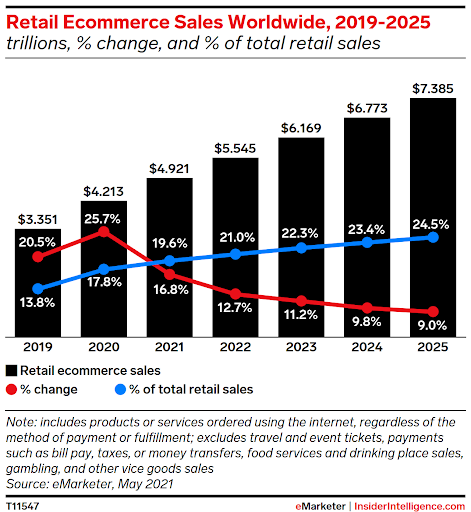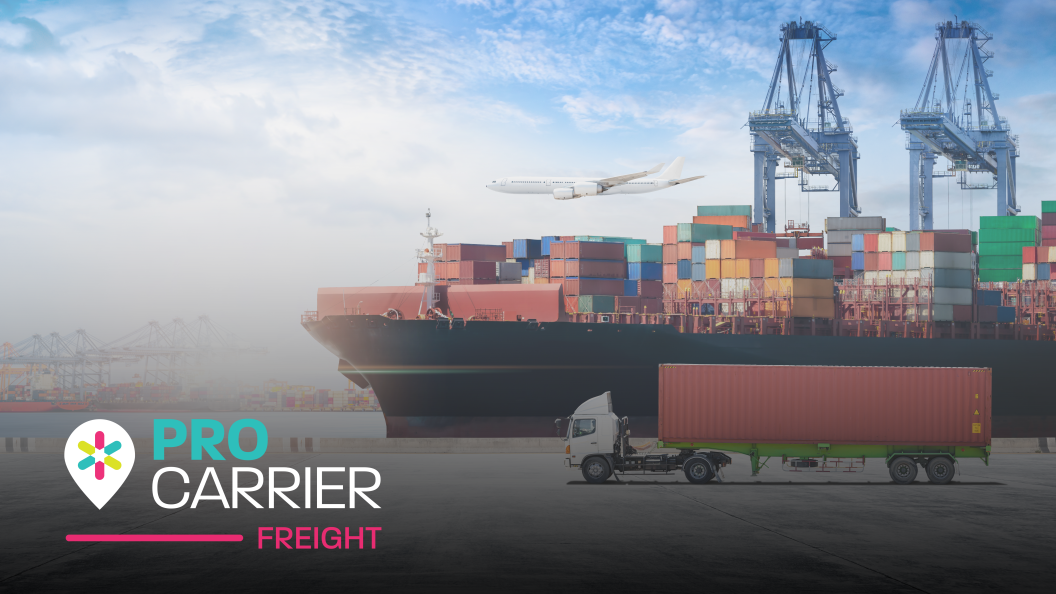Introduction
You don’t need us to tell you that eCommerce is on the rise across the globe. Thanks to a combination of factors, including the pandemic, better technology and increasing consumer confidence, online shopping is becoming the norm.
It’s why so many brands are investing in cross-border eCommerce strategies. And if you’re thinking of entering a new market, it’s vital to know what to expect. This article will provide an in-depth look at global eCommerce trends and what you can expect in the future.
Global eCommerce Market Size
It is estimated that the current global eCommerce market sits at around $5.55 trillion. Not only that, but the figure is expected to grow over the coming years as borderless eCommerce begins to become more popular with consumers and more profitable to retailers.
A few years ago, less than a quarter of sales were made online. However, due to the global pandemic, the adoption of eCommerce has rapidly become the norm and is expected to reach 25% of all retail sales by 2025.
Global eCommerce sales are anticipated to continue rising and accumulate a larger and larger retail market share. It is estimated online retail sales will hit $6.17 trillion in 2023, with eCommerce making up 22.3% of those sales.
On a country-by-country basis, China will continue to lead the way in the global eCommerce market. Sales are expected to grow at an annual compound rate of 11.6% between 2021 and 2025, reaching a staggering $3.3 trillion in 2025.

5 Potential Global eCommerce Trends
So what should you be looking out for as eCommerce continues to grow across the globe. Here are five of the most important trends.
Supply chain fortification
It is no secret that COVID-19 had a major impact on supply chains, causing significant disruption. Just-in-time supply chains broke across the globe during the pandemic, which severely hampered the movement of goods and forced companies to invest significantly into strengthening their logistics processes.
It is expected that these issues will persist until 2023. But even once rectified, these issues have highlighted the problem of just-in-time supply chains. Global importers, exporters and brands will seek to strengthen supply chains, whether that’s outsourcing operations to logistics companies, seeking consulting advice or building their own in-house supply chain.
Buy now, pay later dominance
The buy now, pay later payment method doesn’t look like it is going anywhere. It’s already a popular payment option in the UK as well as other global markets like the US and Australia.
Klarna, one of the largest buy now pay later brands, reported a significant increase in transitions on their platform in 2021, with more brands adopting it every week. Given soaring inflation, a cost of living crisis and the prospect of a recession, expect buy now, pay later to become a common theme on eCommerce checkouts worldwide.
Virtual shopping
Don’t bet against the future of shopping becoming virtual. The metaverse has the potential to remove borders for consumers and allow people worldwide to try out products in the metaverse.
The blurring of digital and physical retail is nothing new. We have already seen brands like Gucci and Nike host fashion shows within popular online games such as Roblox, and Adidas launched its own NFT collection. AR and VR are also becoming increasingly common within a retail setting.
Asia eCommerce growth
One major area that is set to see significant eCommerce growth is the Asia-Pacific region. So much so that in 2023, it is estimated that retail eCommerce sales in this area will surpass the sales made in the rest of the world.
This rapid growth is due to significant technological advancements and urbanization occurring in countries such as Malaysia, Singapore, and the Philippines.
That is not to mention the eCommerce sales anticipated in China. In 2021, China’s eCommerce sales were valued at $2.1 trillion, over double the figures estimated in the US.
Pro Carrier is Your Partner for Cross-Border Commerce
One thing that stands out from all of the reports, forecasts, and trends that seem to be unfolding is that global eCommerce is becoming the norm. The future of any retailer’s growth will depend on how fast and to what extent it can meet consumer needs in global markets.
There’s a lot to consider when entering a cross-border market, but Pro Carrier makes shipping one less thing to worry about. Our decades of experience combined with our network of final-mile delivery partners means we take the complexity out of cross-border commerce and help you ship products effortlessly to any market around the globe. Speak to our experts today to find out more.




Social commerce and mobile shopping
As mentioned already, Covid had a major impact on eCommerce trends worldwide. Brick-and-mortar stores were forced to close overnight, which resulted in many more shoppers heading online to make purchases.
This forced shift in consumer habits significantly accelerated the move to online shopping by as much as five years. Mobile commerce also grew as a result and is expected to increase significantly year over year.
5G wireless, shopping apps, and social shopping are all set to make mobile commerce easier than ever. Social commerce is anticipated to triple by 2025, and almost half of Chinese consumers are already shopping via social media.